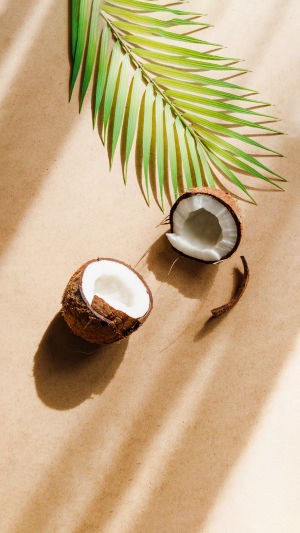Coconuts are tropical fruits that come in two main types: young coconuts and mature coconuts.
Each type has its own special taste, texture, and health benefits. Knowing the differences between them can help you choose the right one for your recipes and nutrition needs.
<h3>Physical Differences</h3>
<b>Young Coconuts:</b>
• Appearance: Young coconuts are usually green or ivory with a smooth, thin outer layer.
• Weight: They are lighter than mature coconuts, making them easier to carry and handle.
• Husk: The husk is softer and easier to pierce, which makes it simple to get to the water inside.
<b>Mature Coconuts:</b>
• Appearance: Mature coconuts have a brown, hairy shell that is thick and tough.
• Weight: They are heavier due to the solid meat inside.
• Husk: The husk is harder and requires more effort to open.
<h3>Nutritional Differences</h3>
<b>Water Content</b>
• Young Coconuts: Young coconuts are full of coconut water, typically offering 1-2 cups per fruit. This water is low in calories and packed with essential electrolytes like potassium, sodium, and magnesium, making it a great natural drink for staying hydrated. The mild sweetness from natural sugars gives you energy without causing a quick rise in blood sugar levels. It's a popular choice for rehydration, especially after a workout or in hot weather.
• Mature Coconuts: As coconuts grow older, the amount of water inside decreases, and what's left becomes thicker and milkier. While this water still helps with hydration, there's less of it because much of it gets absorbed into the growing meat.
<b>Meat Texture and Flavor</b>
• Young Coconuts: The soft, jelly-like meat of young coconuts is lower in fat but rich in fiber, vitamins, and minerals like vitamin C and potassium. It's perfect for light eating and adds a refreshing touch to salads, smoothies, or desserts.
• Mature Coconuts: The meat of mature coconuts is thicker and firmer, with higher fat content, especially medium-chain triglycerides (MCTs), which your body quickly uses for energy. This meat is also a good source of dietary fiber, iron, and copper, supporting digestion and overall health. The rich texture and deep flavor make mature coconut meat versatile for cooking, baking, and making coconut milk or oil.
<h3>Culinary Uses</h3>
<b>Young Coconuts:</b>
• Best for drinks, young coconuts are often enjoyed for their hydrating water. The sweet water and soft meat can also be blended into smoothies or used in desserts.
<b>Mature Coconuts:</b>
• The firm meat of mature coconuts is versatile and adds rich flavor to many dishes. It's commonly used in curries, desserts, and as a topping for various meals.
<b>Mature Coconuts:</b>
• Nutrient Density: Mature coconuts have more fat, especially medium-chain fatty acids, which are good for energy.
• Culinary Versatility: The rich flavor and firm texture of mature coconut meat make it a staple in many recipes, boosting the nutritional value of meals.
<h3>Conclusion</h3>
To sum up, young and mature coconuts differ in many ways, from taste and texture to how they are used in cooking. Young coconuts are great for hydration and light snacks, while mature coconuts are a flavorful ingredient in many dishes. Understanding these differences helps you choose the right coconut for your needs.





